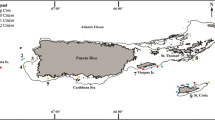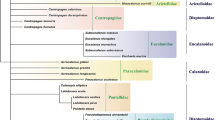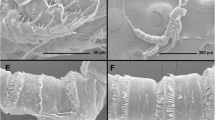Abstract
In small metazoan invertebrates classical taxonomic analyses can be ambiguous due to the limited number of morphological characters available. This difficulty can yield incorrect estimates of species richness or taxa distribution. The Boeckella genus has been described as the dominant taxon of zooplankton assemblages in the Andean biogeographical region. In this genus, taxonomic classification and delimitation of boundaries between species has long been problematic and controversial. Among South American centropagids Boeckella gracilipes has been regarded as one of the most broadly distributed species, its presence having been reported from Ecuador to Tierra del Fuego. However, in the high Andean plateau some centropagid populations identified as Boeckella gracilipes have also been considered as B. gracilipes titicacae or even identified as a different species, namely Boeckella titicacae. In an attempt to resolve the taxonomic status of the Centropagidae family from the high Andean plateau, we combined traditional and multivariate morphological analyses (integral approach) with the molecular phylogenetic approach. The results obtained allow us to conclude that centropagids collected from the high Andean plateau actually represent a different species, B. titicacae, not B. gracilipes. The phylogenetic reconstruction of the South American Centropagidae family indicated that B. gracilipes represents a sister taxon to B. titicacae. The present study stresses the usefulness of integrating alfa-taxonomy with morphometric and molecular approaches in order to resolve species boundaries, to determine geographical distributions and to investigate evolutionary processes.





Similar content being viewed by others
References
Adamowicz, S., P. Hebert & M. Marinone, 2004. Species diversity and endemism in the Daphnia of Argentina: a genetic investigation. Zoological Journal of the Linnean Society 140: 171–205.
Adamowicz, S., S. Menu-Marque, P. D. N. Hebert & A. Purvis, 2007. Molecular systematics and patterns of morphological evolution in the Centropagidae (Copepoda: Calanoida) of Argentina. Biological Journal of the Linnean Society 90: 279–292.
Bayly, I. A. E., 1992a. Fusion of the genera Boeckella and Pseudoboeckella (Copepoda) and revision of their species from South America and sub-Antarticislands. Revista Chilena de Historia Natural 65: 17–63.
Bayly, I. A. E., 1992b. The non-marine Centropagidae (Copepoda:Calanoida) of the world. In Dumont, H. J. (ed.), Guides to the Identification of the Microinvertebrates of the Continental Waters of the World. SPB Academic Publishers, The Hague.
Bayly, I. A. E., 1993. The fauna of Athalassic saline waters in Australia and the Altiplano of South America: comparisons and historical perspectives. Hydrobiologia 267: 225–231.
Bayly, I. A. E., 1995. Distinctive aspects of the zooplankton of large lakes in Australasia, Antarctica and South America. Marine and Freshwater Research 46: 1109–1120.
Colbourne, J. K. & P. D. N. Hebert, 1996. The systematics of North American Daphnia (Crustacea: Anomopoda): a molecular phylogenetic approach. Proceedings of the Royal Society London Series B 351: 349–360.
Crews, S. & M. Hedin, 2006. Studies of morphological and molecular phylogenetic divergence in spiders (Araneae: Homalonychus) from the American southwest, including divergence along the Baja California Peninsula. Molecular Phylogenetics and Evolution 38: 470–487.
Declerck, S. & A. Weber, 2003. Genetic differentiation in life history between Daphnia galeata populations: an adaptation to local predation regimes? Journal of Plankton Research 25: 93–102.
Folmer, O., M. Black, W. Hoeh, R. Lutz & R. Vrijenhoek, 1994. DNA primers for amplification of mitochondrial cytochrome c oxidase subunit I from diverse metazoan invertebrates. Molecular Marine Biology and Biotechnology 3: 294–299.
Geller, J. B., E. Walton, E. Grosholz & G. Ruiz, 1997. Cryptic invasions of the crab Carcinus detected by molecular phylogeography. Molecular Ecology 6: 901–906.
Harding, J. P., 1955. The Percy Sladen Trust expedition to the Lake Titicaca in 1937. Transaction of the Linnean Society of London 3: 219–247.
Hebert, P. D. N., E. A. Remigio, J. K. Colbourne, D. J. Taylor & C. C. Wilson, 2002. Accelerated molecular evolution in halophilic crustaceans. Evolution 56: 909–926.
Hueselnbeck, J. P. & F. Ronquist, 2005. Bayesian analysis of molecular evolution using MrBayes. In Nielsen, R. (ed.), Statistical Methods in Molecular Evolution. Springer-Verlag, New York, NY, USA: 1–53.
Knowlton, N., E. Weil, L. Weigt & H. Guzman, 1992. Sibling species in Montastraea annularis, coral bleaching, and the coral climate record. Science 255: 330–333.
Kumar, S. & S. B. Hedges, 1998. Amolecular timescale for vertebrate evolution. Nature 392: 917–920.
Lefébure, T., C. J. Douady, M. Gouy & J. Gibert, 2006. Relationship between morphological taxonomy and molecular divergence within Crustacea: proposal of a molecular threshold to help species delimitation. Molecular Phylogenetics and Evolution 40: 435–447.
Locascio de Mitrovich, C., A. de Villagra Gamundi, J. Juárez & M. Ceraolo, 2005. Limnological characteristics and zooplankton in five shallow lakes. Puna – Argentina. Ecologia en Bolivia 40: 10–24.
Menu-Marque, S. & C. Locascio de Mitrovich, 1998. Distribución de las especies del género Boeckella (Copepoda: Calanoida: Centropagidae) en la República Argentina. Physis (Buenos Aires), B 56: 1–10.
Menu-Marque, S., J. J. Morrone & C. Locascio de Mitrovich, 2000. Distributional patterns of the South American species of Boeckella (Copepoda, Centropagidae): a track analysis. Journal of Crustacean Biology 20: 262–272.
Mura, G., I. Kappas, A. D. Baxevanis, S. Moscatello, Q. D’Amico, G. M. Lopez, F. Hontoria, F. Amat & T. J. Abatzopoulos, 2006. Morphological and Molecular Data Reveal the Presence of the Invasive Artemia franciscana in Margherita di Savoia Salterns (Italy). International Review of Hydrobiology 91: 539–554.
Posada, D. & K. A. Crandall, 1998. Modeltest: testing the model of DNA substitution. Bioinformatics 14: 817–818.
Riddle, B., D. Hafner, L. Alexander & J. Jaeger, 2000. Cryptic vicariance in the historical assembly of a Baja California Peninsular Desert biota. Proceedings of the National Academy of Sciences USA 97: 14438–14443.
Ronquist, F. & J. P. Huelsenbeck, 2003. MrBayes 3: Bayesian phylogenetic inference under mixed models. Bioinformatics 19: 1572–1574.
Rowe, C. L., S. J. Adamowicz & P. D. N. Hebert, 2007. Three new cryptic species of the freshwater zooplankton genus Holopedium (Crustacea: Branchiopoda: Ctenopoda), revealed by genetic methods. Zootaxa 1646: 1–49.
Rozas, J., J. C. Sánchez-DelBarrio, X. Messegyer & R. Rozas, 2003. DnaSP, DNA polymorphism analyses by the coalescent and other methods. Bioinformatics 19: 2496–2497.
Ski, J. R. & W. Babik, 2000. Genetic differentiation among northern and southern populations of the moor frog Rana arvalis Nilsson in central Europe. Heredity 84: 610–618.
Soto, D. & L. Zúñiga, 1991. Zooplankton assemblages of Chilean temperate lakes: a comparison with North American counterparts. Revista Chilena de Historia Natural 64: 569–581.
Tamura, K., J. Dudley, M. Nei & S. Kumar, 2007. MEGA4: Molecular Evolutionary Genetics Analysis (MEGA) software version 4.0. Molecular Biology and Evolution 24: 1596–1599.
Thomasson, K., 1963. Araucanian Lakes. Plankton studies in North Patagonia with notes on terrestrial vegetation. Acta Phtytogeographica Suecica 47: 1–141.
Thompson, J. D., D. G. Higgins & T. J. Gibson, 1994. CLUSTAL W: improving the sensitivity of progressive multiple sequence alignment through sequence weighting, position-specific gap penalties and weight matrix choice. Nucleic Acids Research 22: 4673–4680.
Villalobos, L., 2006. Estado de conocimiento de los crustáceos zooplanctónicos dulceacuícolas de Chile. Gayana (Concepc.) 70: 31–39.
Villalobos, L. & L. Zúñiga, 1991. Latitudinal gradient and morphological variability of copepods in Chile: Boeckella gracilipes Daday. Verhandlungen Internationale Vereinung für Theoretishe und Angewandte Limnologie 24: 2834–2838.
Wiens, J., 2001. Character analysis in morphological phylogenetics: problems and solutions. Systematic Biology 50: 689–699.
Acknowledgements
The collaboration of officers and staff at the Regimiento Huamachuco is gratefully acknowledged. Research in the Surire salt deposit is part of an ongoing collaboration between CECS and the Chilean Army and was supported in part by HHMI. R. Scheihing holds a postgraduate fellowship from CONICYT. R. Néspolo thanks FONDECYT grant Nº 1090423. Centro de Estudios Científicos (CECS) is funded by the Chilean Government through the Millennium Science Initiative and the Centers of Excellence Base Financing Program of Conicyt. CECS is also supported by a group of private companies, which at present includes Antofagasta Minerals, Arauco, Empresas CMPC, Indura, Naviera Ultragas and Telefónica del Sur.
Author information
Authors and Affiliations
Corresponding author
Additional information
Handling editor: K. Martens
Rights and permissions
About this article
Cite this article
Scheihing, R., Cardenas, L., Nespolo, R.F. et al. Morphological and molecular analysis of centropagids from the high Andean plateau (Copepoda: Calanoidea). Hydrobiologia 637, 45–52 (2010). https://doi.org/10.1007/s10750-009-9983-6
Received:
Revised:
Accepted:
Published:
Issue Date:
DOI: https://doi.org/10.1007/s10750-009-9983-6




